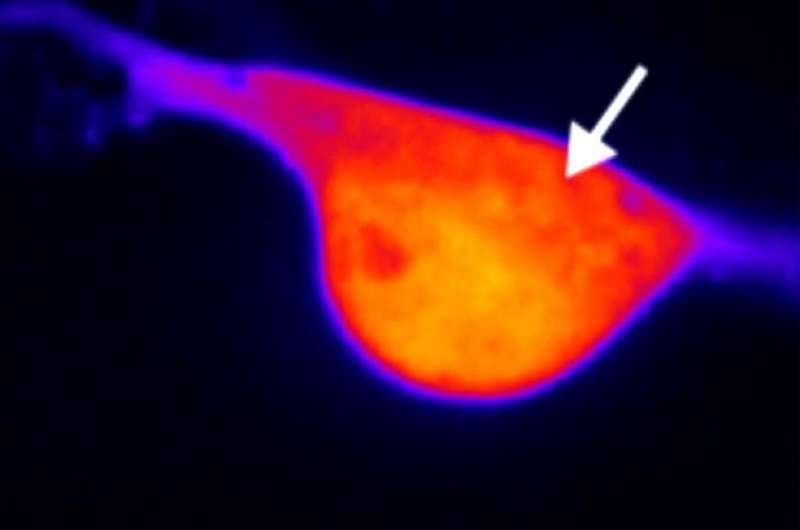Body's 'natural opioids' affect brain cells much differently than morphine

A new study led by UC San Francisco scientists shows that brain cells, or neurons, react differently to opioid substances created inside the body - the endorphins responsible for the "natural high" that can be produced by exercise, for example - than they do to morphine and heroin, or to purely synthetic opioid drugs, such as fentanyl. The researchers say their findings may help explain why the use of synthetic opioids can lead to addiction.
Since both synthetic opioids and the natural, "endogenous" opioids produced in the brain bind to and activate opioid receptors on the surface of nerve cells, scientists have long assumed that both types of molecules target the same cellular systems. But the new research reveals that these molecules also activate opioid receptors inside cells, and that the locations of these activated intracellular receptors differ between natural and synthetic opioids.
In the new study, published in the May 10, 2018 issue of Neuron, the researchers report that this difference could help explain why the effects of synthetic opioid drugs are more rewarding than those produced by endogenous opioids.
"There has been no evidence so far that opioid drugs do anything other than what natural opioids do, so it's been hard to reconcile the experiences that drug users describe—that opioid drugs are more intensely pleasurable than any naturally rewarding experience that they've ever had," said Mark von Zastrow, MD, Ph.D., a professor of psychiatry at UCSF and senior author on the new paper. "The possibility that these opioid drugs cause effects that natural opioids cannot is very intriguing because it seems to parallel this extremely rewarding effect that users describe."
Researchers in von Zastrow's lab collaborated with Aashish Manglik, MD, Ph.D., assistant professor of pharmaceutical chemistry, to create a "biosensor" that binds to the opioid receptors along with an opioid drug or natural opioid. The tool allowed the scientists to see what's happening inside cells, giving them a closer look than ever before at opioids' effects. "It's a way of sniffing out where these receptors are active in the particular types of neurons in which opioids work," explained von Zastrow, a member of the UCSF Weill Institute for Neurosciences.
It has generally been thought that all opioid molecules, natural or synthetic, impart their signal only from receptors on the surface of the cell. Opioid-bound receptors are then taken inside the cell to compartments called endosomes, but receptors were thought not to signal from this location. Overturning this long-held view, the research team discovered that receptors actually remain active in endosomes and they use the endosome to sustain the signal within cells.
But in the most intriguing twist, the research team discovered that morphine and synthetic opioids activate receptors in yet another internal location called the Golgi apparatus, where endogenous opioids are unable to produce any activation at all.
"It really surprised us that there was a separate location of activation for drugs in the Golgi apparatus that could not be accessed by endogenous opioids," said first author Miriam Stoeber, Ph.D., a postdoctoral researcher in von Zastrow's lab. "Drugs, which we generally thought of as mimics of endogenous opioids, actually produce different effects by activating receptors in a place that natural molecules cannot access."
Moreover, morphine and synthetic opioids crossed cell membranes without binding receptors or entering endosomes. They traveled directly to the Golgi apparatus, reaching their target much more quickly than endogenous opioids got into endosomes, taking only 20 seconds compared to over a minute. This time difference could be important in the development of addiction, the researchers said, because typically the faster a drug takes effect, the higher its addictive potential.
The scientists hope to apply their findings to create new types of opioid-based pain medications that have a lower risk for addiction. They also plan to screen other existing medications to see if they act more like natural or synthetic opioids.
"We're very excited about the possibility of leveraging these principles to develop better or more selective drugs that have the ability to get into the brain, but then differ in their activities at internal locations within individual neurons," says von Zastrow. "This is an area that hasn't been explored in drug development because people haven't been thinking about it, but the potential is there."
More information: Miriam Stoeber et al. A Genetically Encoded Biosensor Reveals Location Bias of Opioid Drug Action, Neuron (2018). DOI: 10.1016/j.neuron.2018.04.021 , www.cell.com/neuron/fulltext/S0896-6273(18)30329-5
















